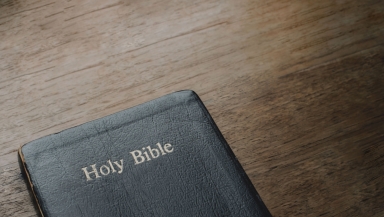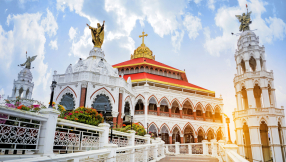
Moriah is a mysterious biblical place name, which has great significance in theology. This is the story ...
Moriah in English
The word Moriah first came into modern English with William Tyndale. In his translation of the Pentateuch published in 1530/1 he refers to the "lande of Moria" in Genesis 22:2. The modern spelling of Moriah comes from the King James Version.
Moriah Chapels
In the Victorian era, Moriah was the name given to many non-conformist chapels in Wales. The most famous one is Moriah Calvinist Methodist Chapel in Loughor, near Swansea. It was there that the 1904 Welsh Revival started, which led to the modern-day Pentecostal movement. Chapels, schools and settlements named Moriah can be found in Wales, Australia, Canada and the United States.
Moriah as a Girl's Name
Since the 1980s, Moriah has started to be used as a girl's name, especially in the United States. For those born since 1990, the name may be a variant of Mariah, due to the popularity of the singer Mariah Carey, whose name when pronounced often sounds like Moriah. Her name is said to have come from the song "They Call the Wind Maria" from the 1951 musical "Paint Your Wagon", so Mariah is in turn a variant of Maria, a form of the name Mary. Moriah is a significant place in the Bible and so has been used by some Christian families. For example Moriah Smallbone, nee Peters, is an American Christian singer and actress who has acted in The Chosen.
Land of Moriah
The story of Moriah goes back to the time when Abraham entered Canaan. Genesis 14 describes Abram's encounter with Melchizedek, king of Salem, later called Jerusalem. Later he moved further south to Beersheba. The 'land of Moriah' is the mysterious location where Abraham went to sacrifice his son Isaac, although he sacrificed a ram instead (Genesis 22:13).
The story relates how Abraham had been in Beersheba and from there he got up early and travelled for two days by donkey. He took with him two servants and his son Isaac, taking with him wood for the fire. On the third day, they saw a mountain far off in the distance and leaving his donkey, Abraham went up with Isaac. The mountain itself is not named and Abraham calls the place 'The LORD will provide' (Gen 22:14 GNB). Abraham created an altar and then instead of sacrificing Isaac, the story says that God led him to find a ram caught in the thicket which he sacrificed instead.
The account is quite brief and lacking in geographical details. There are theories about where this took place, but no one is quite sure what is meant by the 'land of Moriah', mentioned only in Genesis 22:2. It reads like an unoccupied wilderness area, and the mountain reads like a large mountain visible from far away, and the lack of trees is suggested by the need to take wood. It does not fit with being at Jerusalem.
As often happens in the Bible the lack of detail is filled in by later tradition. The story has played a very important part in Jewish, Christian, and Muslim traditions and theology.
The Amorites
From an etymological perspective, it is not certain what the root meaning of Moriah is, although there are ideas. Almost all modern translations render the area Abraham went to as the 'land of Moriah', but some have translated it differently. The Catholic Douay-Rheims had 'land of vision', Brenton's Septuagint translation had 'high land'.
The Aramaic Bible in Plain English has 'land of the Amorites', which reflects the idea that the land of Moriah may refer to the land of the Amorites. The Amorites were a tribe which inhabited Canaan, who are mentioned many times in the Pentateuch. A clue as to where the land of the Amorites was, is found in Genesis 48:22 when it says that the land of the Amorites was given to the tribe of Ephraim, who settled to the north of the tribe of Benjamin, which later became part of Samaria.
Moreh
Another theory is that the name of Moriah might also be a variant of Moreh mentioned three times in the Old Testament. When Abram arrived in Canaan he travelled through the land as far as the site of the great tree of Moreh at Shechem (Genesis 12:6). It is mentioned again in Deuteronomy 11:29-30, in the context of Mount Gerizim. Then in Judges 7:1, we read that Gideon defeated the Midianites in the valley near the hill of Moreh.
An early tradition ascribes the place that Abraham went to as Mount Gerizim, a belief still held by the Samaritan group in the holy land today. Deuteronomy 11:29 gives Mount Gerizim as a place for giving blessings. When the Israelites crossed the River Jordan, Moses commanded the tribes of Simeon, Levi, Judah, Issachar, Joseph and Benjamin to stand on Mount Gerizim to bless the people (Deuteronomy 27:11-13). So the mountain which Abraham went up might be Mount Gerizim, which does fit the description, and it became a sacred site for the Samaritans.
Site of the Temple
The next time we find the place name of Moriah is nearly a thousand years later, and it is the name of a high point at Jerusalem, called Mount Moriah, where the Temple was built. In the Bible, places known as 'Mount' included what in English we might call mountains, or what we might call hills. Jerusalem was built on different hills or mounts, which later were given names like Mount Zion, the Mount of Olives, and Mount Ophel (2 Chronicles 33:14).
The Bible tells us that King David bought a threshing floor from Araunah the Jebusite (2 Samuel 24:18-25). The Jebusites were the original inhabitants of Jerusalem when King David conquered it. The story is told in 1 Chronicles 21:14-16 how David erected an altar there. A threshing floor by its nature is high and flat, making it an ideal location.
For some Jews and Christians there are clear parallels between the story of Abraham going to sacrifice his son Isaac in the land of Moriah, and the Temple on Mount Moriah where sacrifices were made. Many books, websites, and sermons assume that these were the same place, but that is an assumption or a tradition. The Bible accounts do not mention, nor imply, that this is the same place where Abraham tried to sacrifice Isaac.
The Temple
It was after David's death, in the fourth year of Solomon's reign, that King Solomon built the temple on the site (1 Kings 6:1). It is only later in 2 Chronicles 3:1 that we get the reference to the location of the Temple being called Mount Moriah, when the chronicler reviews the events. It reads, "Then Solomon began to build the temple of the Lord in Jerusalem on Mount Moriah, where the Lord had appeared to his father David." The reason for the location is given as, "It was on the threshing floor of Araunah the Jebusite, the place provided by David."
So the place seems to be given the name of 'Mount Moriah' later. This might be to recall the story of Abraham, rather than to suggest it was the same place. In any case the description of Abraham's mountain in the land of Moriah does not fit the description of David's hill called Mount Moriah in Jerusalem, in the land of the Jebusites.
Analogy with Jesus
Some preachers stretch the analogy even further and suggest that Mount Moriah is also the same place where Jesus was crucified in the ultimate sacrifice. The idea that where Abraham went to sacrifice Isaac, where the Temple was built, and where Jesus was crucified are all the same place is very tempting, and an attractive and neat theological thread.
Mount Moriah and Golgotha
The Temple built on Mount Moriah is within the city walls of Jerusalem. Before the time of Jesus, King Herod had developed the Temple area. He enlarged and levelled the hill to make the modern Temple Mount, so people visiting the site today are unaware that the original Mount Moriah was much smaller.
John 18:17-18 states that the place where Jesus was crucified was near the city of Jerusalem, and in Hebrews 13:12 it says Jesus suffered outside the city gates. The place was a rocky outcrop called Golgotha (Matthew 27:33, Mark 15:22, Luke 23;33 and John 19:17), and not Mount Moriah. Jerusalem was considered a holy city and it was not allowed to execute people nor bury people within its walls. The Jews would not have had crucifixions in the sacred temple precincts. Jesus was not crucified on Mount Moriah, but it is enough to say that Golgotha is near Mount Moriah.
Conclusions
Where Abraham went to sacrifice Isaac is not the same place as Mount Moriah, and this is not the same place as Golgotha. These are three different places, but the symbolism and analogy of these three places is important to Christian theology. The idea that the attempted sacrifice of Isaac foreshadows the crucifixion is a theological, not a geographical, connection. The analogy is strong enough without needing them to take place at the same location. It is what happened, not where it happened which is important.













